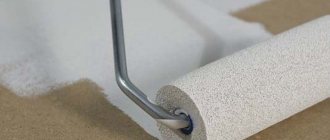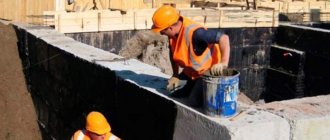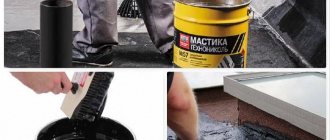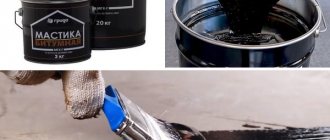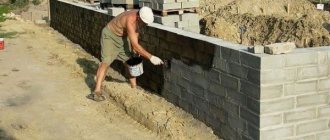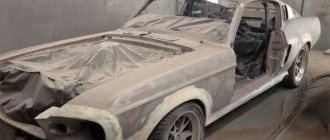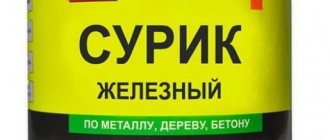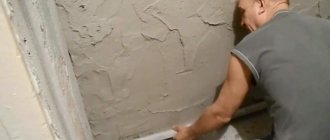Bitumen mastic is used in many construction industries, including highway maintenance. Asphalt concrete pavement tends to deteriorate over time under the influence of high traffic loads and climatic conditions, but certain procedures can significantly extend the service life of the roadway.
“Bitumen mastic is a viscous coating material based on bitumen, with the addition of special synthetic or organic modifiers. Initially it has a liquid but viscous consistency, but after application to the object it hardens, forming a dense monolithic base. Used as a waterproofing, adhesive, fixing or reinforcing material"
The physical and mechanical characteristics of the mastic make it possible to almost 100% eliminate the possibility of leaks, providing reliable, seamless adhesion. In addition, bitumen mastic is capable of providing strong adhesion to almost any materials, which allows it to be used in a variety of construction and repair areas.
In road construction, bitumen-based mastic is used to seal cracks and seal seams. For example, if asphalting in Mytishchi or another small city after completion of the work was accompanied by timely repair of minor damage, the service life of the pavement will increase significantly. For large cities, this rule is also relevant, however, due to the high load on the roads, such prevention may be required more often.
What does bitumen mastic consist of and how is it produced?
Bitumen mastic is produced, in most cases, at specialized production facilities, which are often asphalt concrete plants. Bitumen cooking and bitumen mixing boilers are used as the main equipment.
The basis of this material is petroleum road bitumen, which accounts for up to 70% of the total volume. The remaining 30% is occupied by special modifiers, which may differ depending on the purpose of the mastic.
Consumption and consumption rate
Consumption per 1 sq.m. varies depending on the type of mastic used; hot types do not shrink after drying. The average is 2-2.4 kg/sq.m., with a layer of 2 millimeters. The dry residue has a direct impact on consumption; the lower the indicator, the more product will be required, usually this indicator varies from 20 to 70%.
The average is 2-2.4 kg/sq.m., with a layer of 2 millimeters.
What is bitumen mastic most often made of?
| Component category | Examples of materials | Function |
| Binding base (standard additives) | Petroleum road bitumen | Adhesive properties (adhesion), ductility, hardening |
| Inclusion (standard additives) |
| Providing density, hardness and resistance to low temperatures |
| Thickeners (standard additives) |
| Increased thermal insulation properties, reduced material consumption, ease of application |
| Fiber additives (standard additives) |
| Reinforcing function, ensuring resistance to bending |
| Polymer latex (optional additives) |
| Increases adhesion |
| Rubber additives (optional additives) |
| Increased resistance to high loads due to increased ductility |
| Rubber (optional additives) |
| Increases elongation by 15-20%, due to which there is no destruction at high and low temperatures (including changes) |
| Other modifiers (optional additives) |
| Increased adhesion properties, increased crack resistance and ductility |
In fact, the production of bitumen-based mastics today is often carried out using many other components that can improve certain characteristics, including compensating for the physical and mechanical disadvantages of bitumen.
For example, petroleum bitumen tends to crack when exposed to low temperatures and spread when heated, but modern modifiers, including rubber ones, solve this problem.
Execution of work
Mastics are applied in the manner recommended by the manufacturer and distributed with brushes, a spatula or a roller.
Among the main requirements of the technology are:
Carrying out work under conditions permitted in the instructions. Particular attention is paid to the temperature of the air, the base and the mastic itself; even “winter” types cannot be applied to a frost-covered foundation.- The need for uniform distribution of the composition, the absence of unpainted areas or drips.
- Monitoring the thickness of applied materials after each layer has dried.
- Allow each applied layer to dry completely.
Long breaks in waterproofing work are not dangerous, but undesirable; each layer must be applied completely. Work will be carried out using PPE, all tools and equipment will be cleaned promptly upon completion.
How bitumen mastic is produced
The technology for manufacturing bitumen mastics is based on melting petroleum bitumen and then mixing the base with other components.
Hot mastic production technology:
- 1. Bitumen is loaded into the bitumen boiler (in theory, another suitable container can be used).
- 2. Heating is carried out to approximately 90-100°C (sometimes up to 130-140°C), in order to melt the raw materials and evaporate moisture.
- 3. Hot bitumen is poured into the bitumen mixing boiler, avoiding the temperature drop.
- 4. To prevent foaming during mixing, you can add a defoamer.
- 5. Modifiers are added sequentially (it is necessary to mix the bitumen with the supply of each component).
- 5.1. Another option is that, in parallel with the melting of the bitumen, the remaining components are mixed in another container, after which heated bitumen is poured into it in portions, which is accompanied by mixing.
- 6. The finished composition is poured into metal containers.
“The production process of some types of mastics may differ from the described technologies, but the principle remains unchanged - heating the bitumen and thoroughly mixing it with modifiers and fillers”
Cold type bitumen mastic
It's done a little differently. It is necessary to add a certain amount of a suitable sealer to the bitumen (dilute), then cool the composition to 70-80°C, and then mix it with the filler.
Common brands
The best indicators and user reviews have:
- all lines of TechnoNIKOL mastics;
- cold bitumen mastics Grid, in particular a specialized brand for foundation waterproofing - MGH-G;
- Icopal waterproofing mastic – a composition based on high-quality bitumen and solvent with the addition of corrosion inhibitors and antiseptics;
- Bitumast – mastic for coating waterproofing of foundations, compatible with almost all bitumen and bitumen-polymer materials;
- Suho Izowax is a water-based cold mastic.
Scope of application of bitumen mastic
Bitumen mastic is one of the most common waterproofing and adhesive materials, therefore it is used almost everywhere:
- Sealing seams and cracks of asphalt pavement;
- Repairing cracks in various materials;
- Roofing work (installation and repair);
- Installation of tiles and similar elements;
- Protection of metal elements from corrosion;
- Creation of a moisture-proof layer;
- Waterproofing of objects such as wells, fountains, swimming pools, etc.;
- Processing of interfloor ceilings;
- Waterproofing of foundations, concrete objects;
- Waterproofing of water pipes;
- Insulation of elements of various structures.
Asphalt mastic can be used in almost any application where waterproofing, bonding or protection is required.
Application of mastics. Expert solutions from foundation to roof
In any region, when constructing private buildings or capital structures, builders inevitably face the problem of high-quality waterproofing. In the absence of reliable protection, the destructive effects of moisture can significantly reduce the service life of any structure. Until recently, one of the most popular methods of waterproofing was the use of petroleum bitumen. However, he quickly discovered serious shortcomings. The bitumen film cracks at low temperatures and leaks in hot weather. With the development of innovative technologies, manufacturers managed to improve waterproofing material and offer consumers a qualitatively new product - bitumen mastics.
Bitumen mastics , due to the content of special polymer and mineral additives, provide durable protection against the corrosive effects of moisture.
The building materials market today offers a huge selection of bitumen mastics. In Russia and the CIS countries, one of the largest manufacturers is the TechnoNIKOL company, which sets the main trends in mastic waterproofing. Dmitry Mikhailidi, head of the TechnoNIKOL Engineering and Technical Center, talks about the properties and features of using mastics when arranging waterproofing of building structures.
What kind of construction problems can mastics solve, and how to choose the right product from the wide variety on the market?
Thanks to their performance properties, waterproofing mastics have become perhaps one of the most popular building materials today. It is extremely difficult to find an object whose construction could be done without their use. Mastics are actively used when installing roofs, waterproofing foundations or interfloor slabs. In addition, using mastics you can glue rolled materials and tiles. They are also used to protect metal surfaces from corrosion, provide sealing and perform many other tasks.
It is also important to choose the necessary mastic, based primarily on specific construction tasks. Manufacturers, as a rule, indicate in the instructions the scope and possible purpose of the material. It is also important to remember that mastics are distinguished into two types: cold and hot application, depending on the softening temperature.
Cold application mastics contain a solvent and, accordingly, are sold in a softened form. The applied material hardens after the solvent evaporates. Among cold-hardening mastics, there are also one-component and two-component ones. One-component mastics are a product completely ready for use. , two-component mastics must be prepared by mixing two components, and they have a high drying speed.
Hot application mastics are more suitable for professional use, since before application they must be heated to +160Cº, which requires certain knowledge, skills and equipment.
Mastics can also be water-based for ease of application indoors or solvent-based. Solvent-based mastics are used over a wide temperature range.
Roofing mastic TechnoNIKOL No. 21 (Tehnomast)
Protective aluminum mastic TechnoNIKOL No. 57 (Tehnomast)
What characteristics should roofing mastics have? Is the mastic able to fully withstand the loads on the roofing carpet?
It would not be an exaggeration to call mastic one of the most popular roofing materials. They are quite simple to use: they are easy to apply, harden quickly, and the created hermetic coating does not allow water to pass through. Mastic waterproofing can be used on roofs of any shape and design. The fireless application method allows the use of mastics where the most stringent fire safety requirements are imposed.
Application of roofing mastic
Roofing mastics , unlike waterproofing mastics, have a wider range of operating temperatures from -50ºС to +140ºС and an elongation index of 500%. These characteristics ensure the durability and strength of the mastic roofing carpet, which can withstand sudden temperature changes without any damage.
Installation of a roof with a mastic waterproofing carpet TN-Roofing mast: 1 - Bipol, 2 - TechnoNIKOL Carbon Prof 300 extruded polystyrene foam, 3 - TechnoNIKOL Carbon Prof Slope extruded polystyrene foam, 4 - Reinforced cement-sand screed with a thickness of at least 50 mm, 5 - Bitumen primer TechnoNIKOL No. 01, 6 — TechnoNIKOL mastic No. 21 (Tehnomast), 7 — Fiberglass mesh 40 g/m² with a cell of 2.5 mm, 8 — Fiberglass 90-100 g/m², 9 — Aluminum protective mastic TechnoNIKOL No. 57
As an example, we can consider the installation of a new or reconstruction of an old unused roof of complex shape, with a large number of roofing elements and the inability to use open fire. In this case, the mastic roofing system TN-Roof Mast can serve as an effective solution. The base used here is bituminous material under the Bipol EPP brand. On the one hand, it reliably protects the structure from steam saturation, on the other hand, it demonstrates resistance to possible mechanical damage during installation. Thermal insulation is made using extruded polystyrene foam TechnoNIKOL Carbon Prof 300. Having low thermal conductivity and increased strength, it creates a flat and rigid base on which a cement-sand screed with a thickness of at least 50 mm is mounted.
Application of mastics. Bitumen-polymer mastic for roofing and waterproofing works TechnoNIKOL No. 31
It is important to treat the screed with bitumen primer TechnoNIKOL No. 01, this will significantly increase adhesion. After that, TechnoNIKOL No. 21 mastic (Tekhnomast) is applied in three layers. The mastic must be reinforced with fiberglass and fiberglass mesh. Technomast is a completely finished material that has a number of advantages: high adhesion strength, elasticity up to 500% and flexibility on timber down to -35ºС.
To protect the roofing pie from the destructive effects of ultraviolet radiation, TechnoNIKOL No. 57 aluminum mastic with high reflective properties is used. It prevents excessive heating of the roof, thereby saving on air conditioning on hot days. This material is also successfully used to protect metal roofing from corrosion.
Are there any special features in using mastics for foundation waterproofing? Or is the principle the same everywhere?
When arranging the protection of the foundation from moisture, bitumen mastics also occupy a leading position among waterproofing materials, because they create a sealed protective layer without seams. To install high-quality foundation waterproofing, it is important to choose mastics with certain parameters. It is necessary to pay attention to the indicator of adhesion force to the surface; it should not be lower than 0.1 MPa. TechnoNIKOL No. 21 (Tehnomast), which we have already mentioned, is also perfect for waterproofing foundations.
Using mastic for foundation waterproofing
As an example, consider the TN-Foundation Standard building system. This solution is highly cost-effective and is perfect for laying the foundation of a house with a technical floor or an unused room. TN-Foundation Standard is a prefabricated foundation blocks or monolithic foundation tape, the waterproofing of which is made using bitumen mastic TechnoNIKOL No. 21 (Tekhnomast). This system uses a profiled Planter standard membrane to protect the waterproofing.
Foundation waterproofing device TN-Foundation Standard: 1 — TechnoNIKOL roofing mastic No. 21 (Tehnomast), 2 — TechnoNIKOL bitumen primer No. 01, 3 — Planter standard profiled membrane, 4 — TechnoNIKOL cylinder, 5 — Reinforced concrete foundation structure, 6 — Crushed stone preparation, 7 - Base soil, 8 - Backfill soil, 9 - Transitional side (fillet) cp solution, 10 - Sand preparation
What mastics should be chosen for waterproofing interior spaces? For example, interfloor ceilings?
When carrying out waterproofing work indoors, it is better to use water-based mastics . Such mastics can be used at temperatures up to +5ºС, they dry quickly, and their composition does not contain organic solvents.
The use of mastic for waterproofing interior spaces
When treating a concrete or reinforced concrete floor with mastic, a single waterproof layer without seams is formed, which reliably protects the surface from moisture and is highly elastic. TechnoNIKOL's line of construction solutions includes the innovative TN-Floor Mast system.
Waterproofing of interfloor ceilings and bathrooms TN-Pol Mast: 1 - Reinforced concrete floor slab, 2 - Leveling screed, 3 - TechnoNIKOL bitumen emulsion primer No. 04, 4 - Roofing and waterproofing emulsion mastic, 5 - TechnoNIKOL No. 31, 6 - Cement reinforced -sand screed, 7 - thickness according to the project, 8 - Floor covering
Before laying waterproofing, to increase adhesion, it is recommended to pre-treat the surface with bitumen-emulsion primer TechnoNIKOL No. 04. Then waterproofing made of bitumen-polymer emulsion mastic TechnoNIKOL No. 31 is evenly laid on the prepared base in two layers. After which the surface must be left for 24 hours until completely dry. As additional protection at joints and transitions, the mastic is reinforced with fiberglass with a density of 100-120 g/m² or self-adhesive tape.
After that, a reinforced cement-sand screed and the final floor covering are installed. This waterproofing has high elasticity, adhesive strength and is resistant to moisture.
Bitumen mastic in road construction
Bitumen mastic allows not only to repair minor damage to the road surface, but also significantly increases the service life of the road. As a rule, this material is used to repair asphalt in cases where the width of the damaged area is not greater than the depth of the damage. This procedure is called crack rehabilitation
.
How to rehabilitate cracks:
- 1. The repair area is cleaned of foreign elements, debris and dirt, and dried. Cleaning and drying can be done with high pressure air.
- 2. If necessary, if the width of the damage is too small, the crack is cut - the essence of the procedure is to align the edges of the damaged area to give it the correct geometric shape.
- 3. Bitumen mastic is poured into the damage cavity, usually using a melting and pouring machine.
This procedure is suitable for both straight and branched cracks. This not only fills the voids, but also provides waterproofing that prevents moisture from entering the inner layers of the coating. It also stops further deterioration, thereby increasing the service life of the asphalt pavement.
In addition to eliminating damage, bitumen mastic is used to seal joints on the road surface
. This could be the joints of two separately paved sections, the area around a sewer, or a patch after a pothole repair. Sometimes unmodified bitumen is used for these purposes, but bitumen mastic demonstrates higher efficiency.
What are the advantages and disadvantages of bitumen mastic?
Bitumen mastic has many advantages, the number of which is much greater than the number of disadvantages. Moreover, most of the “disadvantages” of the material can be leveled out by adding modern modifier additives.
Main advantages:
- 1. Almost absolute waterproofness;
- 2. Solid, no seams;
- 3. Low probability of cracking;
- 4. Sufficiently high compressive and tensile strength;
- 5. Necessary elasticity;
- 6. High adhesive characteristics, providing adhesion to almost any material;
- 7. Anti-corrosion effect;
- 8. Long service life - up to 30 years;
- 9. Does not delaminate or swell;
- 10. Suitable for filling voids reliably;
- 11. Allows you to compensate for minor surface unevenness;
- 12. Low consumption;
- 13. Acceptable cost;
- 14. High availability;
- 15. Easy to use.
Potential disadvantages:
- 1. Bitumen mastic can only be applied to a dry, prepared surface;
- 2. Fluidity during installation at high temperatures, approximately from +35°C ( leveled by modifiers
); - 3. Does not tolerate high and low temperatures well ( evened out by modifiers
).
The fluidity of bitumen-based mastic at high temperatures is due to the properties of petroleum bitumen itself. However, due to thickeners, the viscosity can be increased, so that bitumen mastic can be applied even in hot weather.
The first drawback cannot be called critical, especially since today there are no similar materials widely available that could be effectively applied to a wet surface.
Sometimes the disadvantages of this bitumen sealant include long drying, which can take up to 20-24 hours. However, other sealants have approximately the same curing period.
Video description
Here's a short video that should help you find the answer:
It was previously mentioned that the properties of bitumen mastic when waterproofing the foundation allow it to be used even in the presence of rust or contamination. This is true, but it is necessary to understand that comprehensive training, which includes a clean place of work, has a positive effect on service life.
Another point to pay attention to is the attitude of companies towards their employees. If it is good, there is a high chance that this will apply to all aspects of the activity.
Thus, working with bitumen mastic must be carried out in thick clothing specially produced for builders. To avoid damage to the eyeballs from particulate matter and caustic fumes, special glasses are used. If you work with hot mastic, you must use a respirator.
Moreover, safety regulations require that even when working on a simply hot day with high temperatures, no areas of skin are left exposed. Although it cannot be said that only the attitude towards employees is enough to judge the entire company and the results of its activities, the considered nuances are enough for the initial impression.
Employees who are cared for often show better work results Source cs7.pikabu.ru
Recognition of low-quality material
When purchasing something, you want it to be of high quality. By recognizing the problem in advance, you can avoid many undesirable consequences. You don't even need to open the container for this. The point here is that despite its density, mastic is lighter than water. Therefore, a 10-liter bucket cannot possibly contain a substance worth 10 kilograms or even more.
During production, the mastic is poured hot, and it has an increased volume. It is better to avoid all materials that do not meet the required weight values and not allow their use. Otherwise, the created waterproofing will last only a few years. Then you will have to redo it, spending your own time and money. To prevent this, bitumen mastic for waterproofing the foundation must be laid in compliance with technical requirements.
Bitumen mastic according to application technology
| Variety | Features of use |
| Cold application |
Cold-applied bitumen mastic can be used at subzero temperatures, but in this case it will require slight heating to 30-40°C. |
| Hot application |
|
The main features of working with mastic
Avoid open flames, as this material is flammable. If the temperature is already below freezing, the product should be heated. It is applied in layers with special tools, for example, a brush. It is recommended to apply 2 or more layers. One layer dries in approximately 8 hours. It takes a week for the entire product to dry completely and gain all its properties. Approximate material consumption = 1 kilogram of mastic per 1 square meter. The excellent waterproofing characteristics of mastic, its environmental friendliness and ease of installation are truly appreciated by professionals in their field.
Bitumen mastic for its intended purpose
| Purpose | Description |
| Waterproofing | Sealing to prevent moisture and foreign elements from entering |
| Anti-corrosion | Protection of metal products from rust and destruction under the influence of external factors |
| Roofing insulation | Installation and repair of roofing structures |
| Gluing | Strong fixation of various materials |
At the same time, waterproofing bitumen mastic is a multi-purpose material that can be used both for sealing cracks and sealing seams, and for gluing other materials, including roofing elements. However, roofing mastic may not be suitable for sealing, for example, swimming pools or fountains.
Among other things, bitumen mastic can be fireproof and soundproofing, which is achieved by adding certain modifiers. Also, some types of mastic may have different degrees of viscosity, which is also due to the addition of additives.
Today there is another interesting variety of this material - bitumen-aluminum mastic
. It is a mastic with the addition of rubber, filled with aluminum pigment.
Thanks to this, the material has an aluminum color, which makes it stand out from the usual black mastics. This color, in turn, reflects more sunlight, resulting in the object being much less exposed to high temperatures during sunny seasons.
Waterproofing mastics: technical properties
Industrial enterprises do not stop their activities with one specific mastic; they grow and develop, and accordingly, mastics of different directions are produced. The product contains various additives, which directly depend on the type of mastic. Mastic does not emit harmful chemicals. The most popular is bitumen mastic 24; it contains special elements that provide the material with antiseptic and herbicidal characteristics. The product becomes as moisture resistant as possible due to these additives.
Types of bitumen-rubber mastic:
1. Non-drying. This mixture is in a jelly-like form and does not dry out for a long time.
2. Quick-drying. It hardens quickly and takes on the required shape.
3. Drying. Something between the first and second types.
Types of waterproofing mastic:
1. Elastic.
2. Plastic.
3. Solid.
The consumption of the product directly depends on its type. Mastic adheres well to other materials. Waterproofing can be done at any joint.
How to apply bitumen mastic
Bitumen mastic is quite easy to use, as it does not require any special skills. There is a manual and mechanized method of applying mastic - each has its own advantages.
In any case, before application it is necessary to carry out preparatory work:
- 1. The work area must be cleared of foreign elements, dirt, dust, etc.
- 2. After this, you will need to dry the surface to ensure good adhesion.
- 3. In some cases, for example, during roofing work, it is recommended to apply a primer to the surface after cleaning and drying.
The easiest way to perform these steps is to use an air compressor, which, by blowing air under high pressure, can simultaneously clean and dry even deep areas.
Methods of applying mastic
| Way | Description |
| Manual | In this case, you will need a hand tool, which can be used:
The manual method of application is more labor-intensive and time-consuming, but it allows you to control the thickness of the layer, evenly distributing the mastic over the surface. |
| Mechanized | This method involves using special airless sprayer . The pressure when supplying the composition is 150 bar. A specialized sprayer has the function of mixing components without the use of additional tools. The efficiency of mechanized application is much higher, but it is more difficult to control the thickness of the layer and the uniformity of application. |
note
. Bitumen mastic should be applied in several layers. The thickness and number of layers are determined individually. Before applying the next layer, the previous one must be completely dry.
For example, during roofing work, the thickness of the layer will depend on the angle of inclination of the roof:
- Less than 10 degrees – 3 layers of 3-4 mm;
- In the range of 10-20 degrees - 2 layers of 3-4 mm;
- More than 20 degrees – 1 layer 3-4 mm.
“Remember to use safety precautions when working with any bitumen-based materials, as bitumen is a petroleum product that can easily ignite.”
When processing vertical surfaces, bitumen mastic should not be applied in the usual way, but in the opposite way - from bottom to top, in parallel lines. This way the composition fits better on a vertical plane.
It is also recommended to follow the manufacturer's instructions. In some cases, the mastic may need to be kept warm for some time, and sometimes it needs to be diluted with a solvent.
Where is mastic used?
The use of bitumen mastic, as a rule, occurs in the following cases:
Might be interesting
Waterproofing
How to choose the right floor waterproofing for screed?
Waterproofing
Foundation waterproofing: optimal choice of technology
Waterproofing
Clean water is the key to health, waterproofing concrete…
Waterproofing
Instructions for waterproofing a swimming pool
- The composition is used when installing soft tiles on the roof, or rolled material. Its use is justified when repairing leaky roofs and constructing soft bitumen roofs.
- Waterproofing of building foundations. Rubber mastic is used to create an insulating layer when constructing a pile foundation. Other types of compounds can be used as horizontal or vertical waterproofing. Inside the building and outside.
- Waterproofing the floor. Mastic is used under a rough screed or under a self-leveling coating. You can insulate slabs on loggias in basements and garages. It is often used in bathrooms, toilets, and showers.
- Insulation work on terraces and swimming pools. Liquid rubber is well suited for this and can be used on any surface.
The use of these compounds is justified, even despite the considerable cost.
What is the difference between bitumen mastic and ordinary bitumen and bitumen primer?
Bitumen mastic, bitumen primer and regular bitumen have some similar properties and are used to solve similar problems. However, in fact, all three materials have different purposes and basic characteristics.
Bitumen
– a product of petroleum refining that has a solid or resinous consistency. It is characterized by good adhesive properties, which allows it to be used for waterproofing various objects. May be of natural or artificial origin.
Despite its adhesive properties and moisture resistance, bitumen itself does not have high strength and many other characteristics. For the most part, petroleum bitumen is used as a binder component, as well as a semi-finished product for the production of materials such as bitumen mastic and the like.
Bitumen primer
– is actually a solution of petroleum bitumen in certain solvents. It has a liquid consistency and has adhesive properties like other bitumen products. Used for initial surface treatment, acting as a primer.
What it is?
Many people are interested in what mastic is and where I use it. Let's try to figure this out. Mastic is a combination of different components to increase the water resistance of the material. It is made from solvents, plasticizer and antiseptic. The main feature of this substance is its compatibility with various waterproofing elements.
To put it simply, mastic is a highly stable adhesive substance. It is also immediately worth noting that this product is inexpensive, it is reliable and no special skills are needed to work with it.
Comparison of some material characteristics
| Indicator - material | Bitumen mastic | Regular bitumen | Bitumen primer |
| Adhesion | High | High | High |
| Strength | High | Average | Below the average |
| Resistance to external factors | High | Average | Below the average |
| Reinforcing effect | High enough | Weak | Absent |
In other words, bitumen mastic has higher performance and also has many properties that allow it to be used to solve more complex problems that neither ordinary bitumen nor a primer can handle.
Composition and advantages of bitumen mixture
Bitumen mastic is used in construction and repair work. It is used for roofing. Waterproofing foundations and surfaces of structures, swimming pools, tanks and premises for various purposes is unthinkable without such compounds.
Components are added to bitumen that prevent cracking and increase adhesion to the base. This improves waterproofing. To increase the anti-corrosion properties of the coating, special additives are added.
The advantages of bitumen mastics include the following:
- Resistance to aggressive environments, including ultraviolet radiation, high negative and positive temperatures.
- High elasticity.
- High strength.
- Anti-corrosion.
- Easy to apply.
- Uniformity of structure.
conclusions
Bitumen mastic is a relatively viscous material based on petroleum bitumen with the addition of various modifiers to obtain certain properties and physical and mechanical characteristics. After application to the surface, the composition gradually gains strength, forming a seamless monolithic structure.
Main purposes
mastics are waterproofing, sealing cracks, sealing seams and joints, gluing, protecting and reinforcing various materials. Among other things, bitumen-based mastic is used in road construction to eliminate cracks, thereby significantly extending the service life of asphalt pavements.
Bitumen mastic has several varieties
– depending on the application method, main purpose, types of modifiers, as well as unique characteristics. For a specific task, you can choose the most suitable composition.
The right mastic: composition requirements
The correct roofing and waterproofing mastic should have the following properties:
- Homogeneous consistency, without inclusions of filler particles that are not saturated with the binders of the composition.
- The composition, after application, must withstand temperatures of at least 70°C.
- The main characteristics of the material: waterproof, firmly bonds layers of rolled materials, bioresistant. Look for information about these properties on the packaging in the product description.
